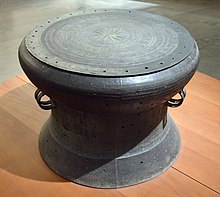
Back حضارة دونغ سون Arabic Donqşon mədəniyyəti Azerbaijani Донгсънска култура Bulgarian Cultura Đông Sơn Catalan Kultura Dong Son Czech Dong-Son-Kultur German Cultura dong son Spanish Đông Sơnin pronssikulttuuri Finnish Culture Dong Son French Kebudayaan Dongson ID
| Part of a series on |
| Prehistoric and ancient cultures of Vietnam |
|---|
| Paleolithic |
| Sơn Vi culture (20,000–12,000 BC) |
| Mesolithic |
| Hoabinhian (12,000–10,000 BC) |
| Neolithic |
|
| Bronze Age |
|
| Iron Age |
|


The Dong Son culture or the Lạc Việt culture (named for modern village Đông Sơn, a village in Thanh Hóa, Vietnam) was a Bronze Age culture in ancient Vietnam centred at the Red River Valley of northern Vietnam from 1000 BC until the first century AD.[1]: 207 Vietnamese historians attribute the culture to the states of Văn Lang (Lạc Việt people) and Âu Lạc (Âu Việt people), and consider it to be the first Vietnamese culture. Its influence spread to other parts of Southeast Asia, including Maritime Southeast Asia, from about 1000 BC to 1 BC.[2][3][4] The Đông Sơn culture was close to the Tai peoples.[5][6][7][8][9][10][11][12][13]
The Dong Son people were skilled at cultivating rice, keeping water buffalos and pigs, fishing and sailing in long dugout canoes. They also were skilled bronze casters, which is evidenced by the Dong Son drum found widely throughout northern Vietnam and Guangxi in China.[14]
To the south of the Dong Son culture was the Sa Huỳnh culture of the proto-Chams.
- ^ Higham, C., 2014, Early Mainland Southeast Asia, Bangkok: River Books Co., Ltd., ISBN 9786167339443
- ^ Vietnam Tours Archived 2013-04-26 at the Wayback Machine
- ^ Nola Cooke, Tana Li, James Anderson - The Tongking Gulf Through History - Page 46 2011 -"Nishimura actually suggested the Đông Sơn phase belonged in the late metal age, and some other Japanese scholars argued that, contrary to the conventional belief that the Han invasion ended Đông Sơn culture, Đông Sơn artifacts, ..."
- ^ Vietnam Fine Arts Museum 2000 "... the bronze cylindrical jars, drums, Weapons and tools which were sophistically carved and belonged to the World famous Đông Sơn culture dating from thousands of years; the Sculptures in the round, the ornamental architectural Sculptures...."
- ^ Schliesinger, Joachim (2018). Origin of the Tai People 6―Northern Tai-Speaking People of the Red River Delta and Their Habitat Today Volume 6 of Origin of the Tai People. Booksmango. pp. 3–4, 22. ISBN 978-1641531832.
- ^ Alves 2019, p. 7.
- ^ McColl et al. 2018. "Ancient Genomics Reveals Four Prehistoric Migration Waves into Southeast Asia". Preprint. Published in Science. https://www.biorxiv.org/content/10.1101/278374v1 cited in Alves, Mark (10 May 2019). "Data from Multiple Disciplines Connecting Vietic with the Dong Son Culture". Conference: "Contact Zones and Colonialism in Southeast Asia and China's South (~221 BCE – 1700 CE)"At: Pennsylvania State University
- ^ Ha, Hao Huu; Nguyen, Trang Hong; Tran, Linh Huyen; et al. (2019). "Genetic characteristics of 23 Y-chromosomal STRs in the Kinh population in Northern Vietnam". International Journal of Legal Medicine. 133 (5): 1403–1404. doi:10.1007/s00414-019-02098-x. PMID 31183551 – via Springer Link.
- ^ "Zuojiang Huashan Rock Art Cultural Landscape - UNESCO World Heritage". www.chinadiscovery.com. Retrieved 2020-01-20.
- ^ "The Rock Painting of the Mountain Huashan - UNESCO World Heritage Tentative List". Archived from original
- ^ "黎族 (The Li People)" (in Chinese). 国家民委网站 (State Ethnic Affairs Commission). 14 April 2006. Retrieved 22 March 2020.
在我国古籍上很早就有关于黎族先民的记载。西汉以前曾经以 "骆越",东汉以"里"、"蛮",隋唐以"俚"、"僚"等名称,来泛称我国南方的一些少数民族,其中也包括海南岛黎族的远古祖先。"黎"这一族称最早正式出现在唐代后期的文献上...... 南朝梁大同中(540—541年),由于儋耳地方俚僚(包括黎族先民)1000多峒 "归附"冼夫人,由"请命于朝",而重置崖州。
- ^ Sterling, Eleanor J.; Hurley, Martha Maud; Minh, Le Duc; Le, Minh Duc; Powzyk, Joyce A. (2006). Vietnam: a natural history. Yale University Press. p. 28. ISBN 0-300-10608-4.
- ^ Stevenson, John; Guy, John; Cort, Louise Allison (1997). Vietnamese ceramics: a separate tradition. Art Media Resources with Avery Press. p. 109.
- ^ SOLHEIM, WILHELM G. (1988). "A Brief History of the Dongson Concept". Asian Perspectives. 28 (1): 23–30. ISSN 0066-8435. JSTOR 42928186.
© MMXXIII Rich X Search. We shall prevail. All rights reserved. Rich X Search